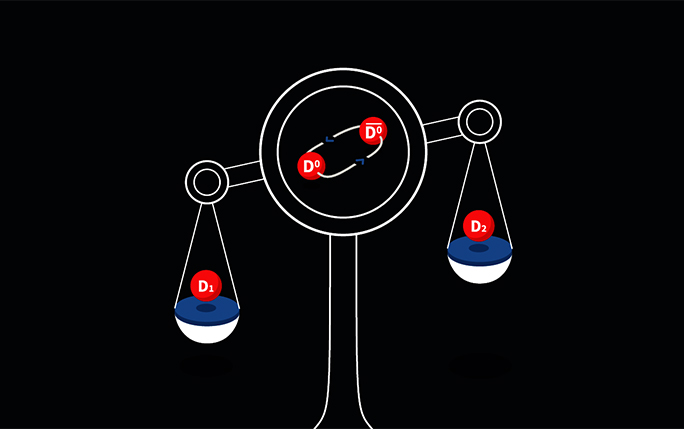Particle seen switching between matter and antimatter at CERN

Physicists have proved that a subatomic particle can between matter and antimatter, in a new discovery revealed earlier this month. The extraordinarily precise measurement was made by UK researchers using the Large Hadron Collider beauty (LHCb) experiment at CERN. It has provided the first evidence that charm mesons can change into their antiparticle and back again.
Within Accelerators Validating Antimatter physics (AVA), the Innovative Training Network focuses on new scientific and technical developments in antimatter research. The pan European network, via 16 Fellows based at universities, industry and research facilities such as CERN and GSI, has enabled world-class research with low energy antiprotons.
For more than 10 years, scientists have known that charm mesons, subatomic particles that contain a quark and an antiquark, can travel as a mixture of their particle and antiparticle states. It is a phenomenon called mixing. However, this new result by the LHCb collaboration shows for the first time that they can oscillate between the two states.
Antimatter is sort of the “twin” of normal matter, but it’s surprisingly similar – in fact, the only real difference is that antimatter has the opposite charge. That means that if ever a matter and antimatter particle come into contact, they will annihilate each other in a burst of energy. To complicate things, some particles, such as photons, are actually their own antiparticles. Others have even been seen to exist as a weird mixture of both states at the same time, thanks to the quantum quirk of superposition. That means that these particles actually oscillate between being matter and antimatter.
And now, a new particle has joined that exclusive club – the charm meson. This subatomic particle is normally made up of a charm quark and an up antiquark, while its antimatter equivalent consists of a charm antiquark and an up quark. Normally those states are kept separate, but the new study shows that charm mesons can spontaneously switch between the two.
Using data collected during the second run of the Large Hadron Collider (LHC), researchers from the LHCb collaboration, with major contributions by physicists based at the Universities of Oxford and Warwick, measured a difference in mass between the two particles. There was a difference of 0.00000000000000000000000000000000000001 (1×10-38) grams. A measurement of this precision and certainty is only possible when the phenomenon is observed many times. Charm mesons are produced at the LHC in proton-proton collisions, and normally they only travel a few millimeters before they decay into other particles. By comparing the charm mesons that tend to travel further versus those that decay sooner, the team identified differences in mass as the main factor that drives whether a charm meson turns into an anti-charm meson or not. As the measurement is extremely precise, the research team ensured the analysis method was even more so.
| LHCb is one of the four large experiments at the LHC at CERN in Geneva, and is designed to study decays of particles containing a beauty quark. The primary goal of LHCb is to investigate matter-antimatter asymmetry known as the ‘CP violation’. Mesons are part of the large class of particles made up of fundamental particles called quarks, and contain one quark and one antimatter quark. The D0 meson consists of a charm quark and an up antiquark, and its antiparticle, the anti-D0, consists of a charm antiquark and an up quark. This measurement was made using LHCb’s Vertex Locator (VELO) subdetector. The design and construction of VELO was funded by Science and Technology Facilities Council, and led by physicists at the University of Liverpool. |
|---|
This discovery of oscillation in the charm meson particle opens up a new and exciting phase of physics exploration. Researchers now want to understand the oscillation process itself, potentially a major step forward in solving the mystery of matter-antimatter asymmetry. A key area to explore is whether the rate of particle-antiparticle transitions is the same as that of antiparticle-particle transitions. And specifically, whether the transitions are influenced or caused by unknown particles not predicted by the Standard Model.
The result is a milestone in the study of how a particle known as a D0 meson changes from matter into antimatter and back. The research has recently been submitted to Physical Review Letters and is already available on arXiv. Further information can be found via the CERN website.
More information
Observation of the mass difference between neutral charm-meson eigenstates, LHCb collaboration, arXiv:2106.03744 [hep-ex]
https://arxiv.org/abs/2106.03744